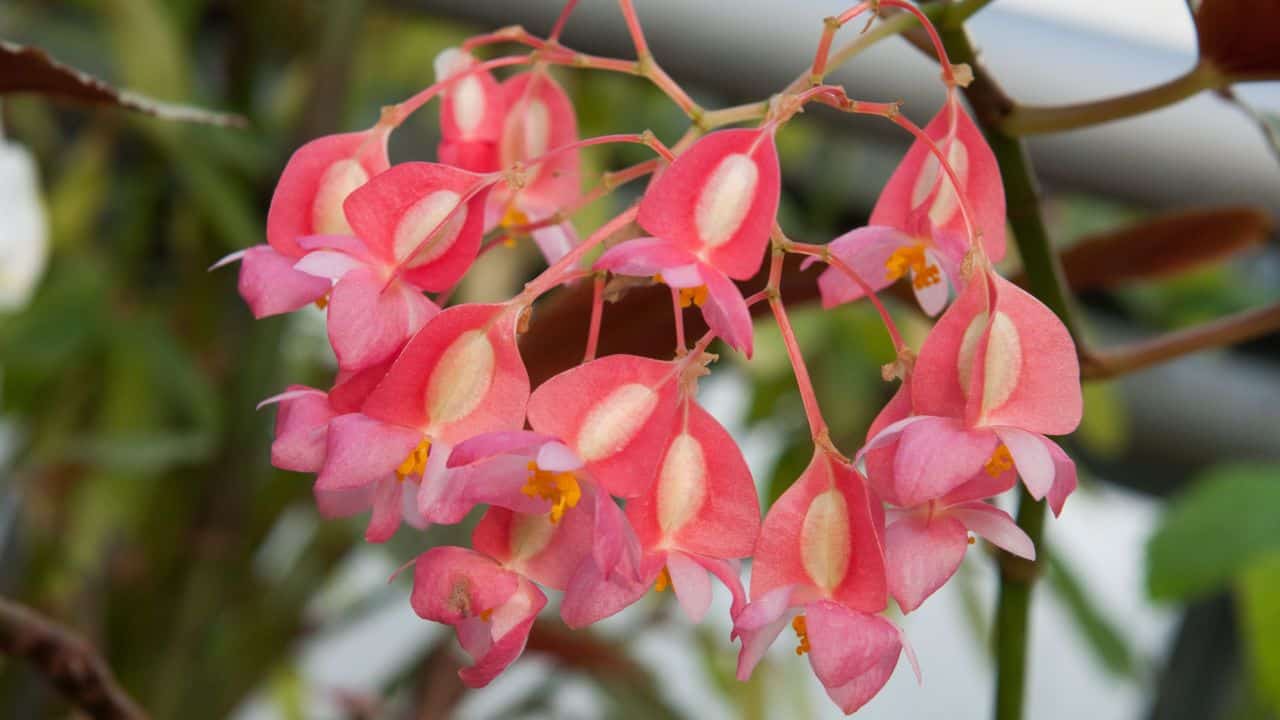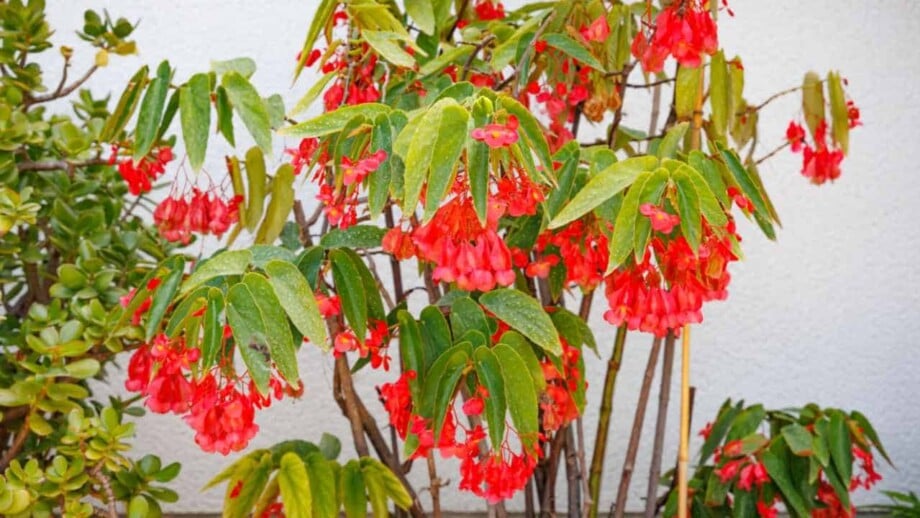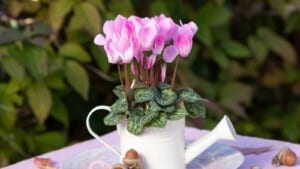Angel Wing Begonia, also known as Begonia coccinea, is a beautiful and popular plant among gardeners, thanks to its stunning foliage. Its unique leaves resembling the wings of an angel make it a stunning addition to any indoor or outdoor garden.
Growing an angel wing begonia indoors produces a year-round houseplant with attractive foliage. The foliage is speckled or streaked and appears on glossy green leaves with red tints or backing. If placed correctly, an angel wing begonia houseplant will bloom in pendulous clusters of flowers. right area.
Cane begonias are among the best-performing and easiest-to-grow begonias. They are only second to wax begonias in terms of ease of cultivation and beauty.
Angel wing begonias are the most well-known type of begonia. The plant is native to Brazil and grows on upright stems with interesting dotted leaves, vibrant colors, and a spectacular display of flowers.
The plants are not difficult to grow and can be planted and grown indoors all year if a few basic requirements are met. They will grow at a moderately fast rate, with noticeable growth visible in as little as six weeks.
In this article, I’ll guide you through the process of planting, growing, and caring for Angel Wing Begonia with my years of experience as a master gardener. I’ll help you learn exactly how to care for them so that you can enjoy their beauty for years to come.

Botanical Name: Begonia coccinea
Common Name: Angel Wing Begonia
Family: Begoniaceae
Plant Type: Perennial
Hardiness Zones: 10-12
Sun Exposure: Partial shade to full shade
Soil Type: Well-drained, fertile soil
Soil pH: 6.0-7.0
Bloom Time: Spring to fall
Flower Color: Red, pink, or white
Native Area: South America
Angel Wing Begonia Care
Angel Wing Begonias, scientifically known as Begonia coccinea, are stunning plants that add a touch of elegance to any indoor or outdoor space. Native to the tropical rainforests of Brazil, these begonias are cherished for their unique leaves that look like folded angel wings and vibrant blooms.
Angel wing begonias make wonderful, large additions to outdoor gardens in warm climates. They require shade from direct sun and moist, well-draining soil. Most varieties also thrive in containers with drainage holes, both indoors and out.
They can be kept inside in a bright spot all year or moved outside in the summer. When overnight temperatures reach 55°F, it is time to bring them inside for the winter.
Keep the plants at eye level to enjoy their distinct appearance as much as possible. These plants can grow to be quite large, with slightly brittle stems developing along the way. Larger plants should be staked up to protect their canes because the foliage is so lovely.
Angel wing begonias may not flower if there is insufficient light, a cold snap, or inadequate fertilizer. They require shade from the direct sun, but plenty of bright indirect light. Keep them above 55°F and begin feeding them with a high phosphorus flowering food in the spring.
To ensure your Angel Wing Begonia thrives, let’s delve deeper into its care requirements.
Light
When it comes to light, Angel Wing Begonia prefers bright, indirect light. Direct sunlight can scorch its delicate leaves, so it’s best to place it near a window that receives filtered sunlight.
However, too little light can result in the plant becoming leggy and losing its vibrant colors. It’s essential to strike a balance and observe how the plant responds to its light conditions.
One interesting fact about Angel Wing Begonias is that they have evolved to thrive in the understory of the rainforest, where they receive dappled sunlight. This adaptation allows them to grow and flourish in shaded areas with filtered light. Mimicking these natural conditions will ensure optimal growth for your begonia.
Soil
Providing the right soil for Angel Wing Begonia is crucial for its overall health. A well-draining soil mix enriched with organic matter is ideal. You can create a suitable mix by combining equal parts of peat moss, perlite, and rich garden soil. This blend ensures proper drainage while retaining enough moisture for the plant’s roots.
In their natural habitat, Angel Wing Begonias grow in the rainforest floor, where the soil is rich in organic matter and provides excellent drainage. This type of soil composition allows the plant’s roots to breathe and prevents waterlogged conditions that can lead to root rot. By recreating these soil conditions, you are providing your begonia with a nurturing environment.

Water
Watering Angel Wing Begonia correctly is essential to prevent both overwatering and underwatering. As a rule of thumb, water the plant when the top inch of soil feels dry to the touch.
Remember to use room temperature water and ensure that the water does not accumulate in the saucer to avoid root rot. Additionally, misting the leaves occasionally will help maintain the plant’s desired humidity level.
In their natural habitat, Angel Wing Begonias receive regular rainfall, but the soil quickly drains excess water.
To mimic this natural watering pattern, it’s important to water your begonia thoroughly and allow the excess water to drain out. This prevents water from sitting in the pot, which can lead to root rot and other fungal diseases.
Temperature and Humidity
Angel Wing Begonia thrives in moderately warm temperatures ranging from 65°F to 75°F (18°C to 24°C). It’s important to protect the plant from extreme temperature fluctuations, such as drafts or excessive heat.
In terms of humidity, the plant prefers moderate to high humidity levels. Placing the pot on a tray filled with water and pebbles or using a humidifier can help create the desired humidity.
In arid climates or if kept indoors, they may require additional humidity, especially during the dry winter months. You can lightly mist them but do not leave droplets on the leaves for too long. To supplement indoors, place them on a pebble tray filled with water or run a humidifier nearby.
Fertilizer
Feeding your Angel Wing Begonia with a balanced, water-soluble fertilizer every two weeks during the growing season will provide it with essential nutrients. Dilute the fertilizer to half the recommended strength to prevent over-fertilization, which can damage the plant. During the dormant season, reduce fertilization to once a month or suspend it altogether.
Angel Wing Begonias have a moderate appetite for nutrients, and regular fertilization ensures they receive the necessary elements for healthy growth. The balanced fertilizer provides a mix of nitrogen, phosphorus, and potassium, which promotes strong foliage, vibrant blooms, and overall plant vigor.
Types of Angel Wing Begonia
The genus Begonia encompasses a wide variety of species and cultivars, each with its unique characteristics and charm. Here are the most common types of Angel Wing Begonia that you can consider adding to your collection:

Begonia ‘Silver Wings’: It’s a hybrid variety that combines the beauty of Begonia coccinea with unique silver-spotted foliage.
Begonia ‘Corallina de Lucerna’: With its coral-colored flowers and glossy green leaves, this cultivar brings a tropical vibe to your garden. Its coral-colored flowers resemble delicate coral reefs, while the glossy green leaves provide a lush backdrop.
Begonia ‘Gryphon’: This unique variety showcases large, scalloped leaves with an interesting silver pattern and bronze undersides. The leaves feature an intricate silver pattern, creating a mesmerizing display.
Begonia ‘Dragon Wing’: Characterized by its abundant red or pink flowers and glossy, asymmetrical leaves, this cultivar is a showstopper. The glossy, asymmetrical leaves add an interesting touch to the overall appearance of the plant.
Begonia ‘Charles Jaros’: This dwarf hybrid can reach a height of 2′ and has lovely pink flowers.
Begonia ‘Splish Splash’: This variety has deep green foliage with white splashes and dark pink flowers.
How to Propagate Angel Wing Begonia
Propagating Angel Wing Begonia is an exciting and rewarding process that allows you to create new plants from existing ones. Not only does it save you money, but it also gives you the opportunity to share your love for these beautiful plants with others.
Propagation via Stem Cutting
When selecting a stem for propagation, it is important to choose a healthy one with at least two nodes. Nodes are the points on the stem where leaves emerge, and they are crucial for root development. By removing the lower leaves, you create a clean and clear area for root growth, ensuring the best chances of success.
Once you have prepared your stem cutting, it’s time to dip the cut end in a rooting hormone. Rooting hormones contain growth-promoting substances that help stimulate root formation. By using a rooting hormone, you give your cutting an extra boost and increase the likelihood of successful propagation.
After treating the stem with rooting hormone, it’s time to plant it in a well-draining potting mix. Well-draining soil is essential for preventing waterlogged conditions, which can lead to root rot. Choose a potting mix specifically designed for propagation, as it provides the ideal balance of moisture retention and aeration.
Once you have planted the stem cutting, it’s important to keep the soil lightly moist. Overwatering can drown the developing roots and hinder their growth. On the other hand, allowing the soil to dry out completely can lead to dehydration and root failure. Finding the right balance is key to successful propagation.
As you patiently wait for roots to develop, it’s important to provide your cutting with the optimal conditions for growth. Place the pot in a warm and bright location, but avoid direct sunlight, as it can scorch the delicate leaves. Maintaining a consistent temperature and humidity level will encourage root development and overall plant health.

Propagation via Leaf Cutting
Leaf cutting is another popular method for propagating Angel Wing Begonia. This method allows you to create new plants from a single leaf, making it an efficient way to expand your collection. When selecting a leaf for propagation, choose a healthy one with vibrant color and no signs of disease or damage.
To prepare the leaf cutting, make a clean cut at the base of the petiole, which is the part that connects the leaf to the stem. By making a clean cut, you ensure that the leaf has the best chance of developing new roots. Insert the leaf into a moistened, well-draining potting mix, burying the cut end to encourage root growth.
To maintain the necessary moisture levels for successful leaf cutting propagation, cover the pot with a plastic bag or a propagator. This creates a mini greenhouse effect, trapping moisture and creating a humid environment that promotes root development. Be sure to check the moisture levels regularly and adjust as needed to prevent mold or fungal growth.
After a couple of weeks, you should start seeing new roots emerging from the leaf cutting. This is an exciting milestone that indicates successful propagation. Once the roots have developed, you can carefully transplant the new plant into its own pot, ensuring it has enough space to grow and thrive.
Remember, propagating Angel Wing Begonia requires patience and care. Not every cutting will root successfully, but with practice and experience, you will improve your success rate. Enjoy the process of creating new plants and watch as your collection grows.
Potting and Repotting Angel Wing Begonia
When potting your Angel Wing Begonia for the first time, it is important to choose the right pot size and soil mix. Select a pot that allows for proper drainage and is just slightly larger than the plant’s root ball. This will provide enough room for the roots to spread out and grow. Additionally, using a well-draining soil mix is essential to prevent waterlogged roots and promote healthy root development.
After selecting the appropriate pot and soil mix, it’s time to pot your Angel Wing Begonia. Gently remove the plant from its nursery container, being careful not to damage the delicate roots. Place the plant in the center of the pot and fill the remaining space with the soil mix. Pat the soil lightly around the roots to secure the plant in place.
Once the potting process is complete, it’s essential to water your Angel Wing Begonia thoroughly. This will help settle the soil and ensure that the roots are properly hydrated. Be sure to water until you see water draining out of the bottom of the pot, indicating that the soil is saturated.
Angel wing begonias seem to thrive when they are slightly pot-bound, so only repot them when absolutely necessary like when the plant has exhausted its potting media or the pot is tipping over.

Repotting Angel Wing Begonias
Repotting begonias should be done in early spring, just as the first flush of new growth appears. However, do not attempt to repot a plant that is in bloom, as the shock will cause the flowering to stop.
When it’s time to repot, carefully remove the plant from its current pot. Gently untangle the roots, being cautious not to cause any damage. If you come across any damaged or overcrowded roots, it’s best to trim them off to promote healthy root growth. Trimming the roots will also help the plant establish itself in its new pot.
After preparing the roots, select a slightly larger pot than the previous one. This will give the plant ample room to grow and expand its root system. Fill the new pot with fresh soil, making sure to use a well-draining mix. Place the Angel Wing Begonia in the center of the pot and fill the remaining space with soil, ensuring that the roots are covered.
Once the repotting process is complete, follow the initial potting instructions to water the plant thoroughly. This will help the plant adjust to its new environment and encourage healthy root development.
By following these potting and repotting guidelines, you can provide your Angel Wing Begonia with the optimal growing conditions it needs to thrive. Remember to monitor your plant’s growth and repot as necessary to ensure its continued health and beauty.
Common Pests, Plant Diseases, and Plant Problems for Angel Wing Begonia
While Angel Wing Begonia is generally a low-maintenance plant, it is not immune to pests, diseases, and problems. The most common issues include aphids, whiteflies, mealybugs, powdery mildew, and yellowing leaves.
Aphids, those tiny insects that cluster on the leaves and stems, can cause damage by sucking the sap and causing yellowing or distorted growth. To control aphids, you can make a solution of mild liquid soap and water and spray it onto the plant. The soap suffocates the aphids and helps control their population.
Mealybugs, on the other hand, appear as fuzzy white or gray patches on the plant. They feed on the sap and can cause stunted growth and leaf drop. To remove mealybugs, simply wipe the affected areas with a cotton swab dipped in rubbing alcohol. This will kill the pests and prevent further damage.
Powdery mildew is a fungal disease that manifests as a powdery white coating on the leaves. It thrives in humid conditions and can spread rapidly if not addressed. To control powdery mildew, improve air circulation around the plant by placing a fan nearby. Additionally, you can apply a fungicide recommended for powdery mildew control to prevent further infection.
Lastly, yellowing leaves can be a sign of various issues, including overwatering, underwatering, or insufficient light. Overwatering can lead to root rot, while underwatering can cause the plant to become dehydrated. Adjust your watering routine accordingly, allowing the top inch of soil to dry out before watering again. If the plant is not receiving enough light, consider moving it to a brighter location or supplementing with artificial grow lights.
By being proactive and addressing any pest infestations, diseases, or problems promptly, you can ensure that your Angel Wing Begonia remains healthy and vibrant. Regularly inspect the plant for any signs of trouble, such as discolored leaves, unusual growth patterns, or pests. With proper care and attention, your Angel Wing Begonia will continue to thrive and bring beauty to your indoor space.
Other Flower Guides from Planet Natural:
Begonia: How to Plant, Grow and Care for Begonia Plant
The Best Hanging Plants in 2023 + How and Where to Hang Them












